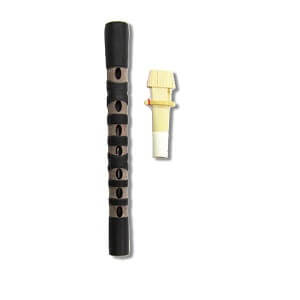Hichiriki
 The hichiriki is a double-reed aerophone of Japan. It is associated most strongly with Imperial court music, in particular the Shinto ritual music called mikagura (in which the hichiriki is joined by the wagon zither, the kagura-bue side-blown flute, and the shakubyoshi concussion sticks); and the gagaku ensemble (with a varied collection of idiophones, membranophones, chordophones, and other aerophones). These genres, and therefore the hichiriki as well, can also be heard at a few Shinto shrines outside of the Imperial household on special ceremonial occasions.
The hichiriki is a double-reed aerophone of Japan. It is associated most strongly with Imperial court music, in particular the Shinto ritual music called mikagura (in which the hichiriki is joined by the wagon zither, the kagura-bue side-blown flute, and the shakubyoshi concussion sticks); and the gagaku ensemble (with a varied collection of idiophones, membranophones, chordophones, and other aerophones). These genres, and therefore the hichiriki as well, can also be heard at a few Shinto shrines outside of the Imperial household on special ceremonial occasions.
A few gagaku ensembles have been established at Shinto shrines and in ethnomusicology programs outside of Japan, in particular in the United States (Hawaii, California, and Washington). Throughout its entire history, the playing and teaching of the hichiriki has been restricted to the male members of a few family lineages serving the Imperial Household. Only in recent decades has it begun to be taught outside of this domain. One hereditary carrier of the hichiriki, Togi Hideki, took the bold and controversial action to move the hichiriki into the commercial music realm of New Age music (the audio clip, taken from one of his releases, features him playing unaccompanied in traditional style).
The body of the hichiriki is cylindrical but the shape of its bore is reverse conical with a diameter of approximately 0.6 inch at the reed end and 0.4 inch at the distal end. It is made from a stalk of bamboo wrapped with bark and bound with string, and then coated both inside and out (the binding only) with lacquer (Hughes p. 217). Seven oblong-shaped fingerholes penetrate the topside of the instrument with slightly larger gaps between the first and second (from the reed-end) and fourth and fifth ones. It is in these larger gaps that on the reverse side (see detail image) are located two thumbholes, again with the distinctive oblong shape. The reed is made from natural reed (ashi) slightly flattened out and dried before being cut and shaped to size (Provine p. 63), and a cane ring is fitted over the finished reed that can be slid up and down by the performer to make subtle adjustments to the instrument’s sound quality. The round base of the reed fits snugly against the top end of the bore, which is recessed about an inch from the end of the body.